| North Sea | |
|---|---|
| Location | Atlantic Ocean |
| Coordinates | 56°N 3°ECoordinates: 56°N 3°E |
| Primary sources | Forth, Ythan, Elbe, Weser, Ems, Rhine/Waal, Meuse, Scheldt, Spey, Tay, Thames, Humber, Tees, Tyne, Wear, Crouch |
| Basin countries | Norway, Denmark, Germany, Netherlands, Belgium, France and the United Kingdom (England, Scotland) |
| Max length | 960 km (600 mi) |
| Max width | 580 km (360 mi) |
| Surface area | 750,000 km2 (290,000 sq mi) |
| Average depth | 95 m (312 ft) |
| Max depth | 700 m (2,300 ft) |
| Water volume | 94,000 km3 (23,000 cu mi) |
| Salinity | 3.4 to 3.5% |
| Max temperature | 17 °C (63 °F) |
| Min temperature | 6 °C (43 °F) |
| References | Safety at Sea and Royal Belgian Institute of Natural Sciences |
The North Sea has long been the site of important European shipping lanes as well as a major fishery. The sea is a popular destination for recreation and tourism in bordering countries and more recently has developed into a rich source of energy resources including fossil fuels, wind, and early efforts in wave power.
Historically, the North Sea has featured prominently in geopolitical and military affairs, particularly in Northern Europe but also globally through the power northern European actors projected worldwide during much of the Middle Ages and modern era. The North Sea was center of the Vikings' rise and subsequently, the Hanseatic League, the Netherlands, and the British each sought to dominate the North Sea and through it to control access the markets and resources of the world. As Germany's only outlet to the ocean, the North Sea continued to be strategically important through both World Wars.
The coast of the North Sea presents a diversity of geological and geographical features. In the north, deep fjords and sheer cliffs mark the Norwegian and Scottish coastlines, whereas the south consist primarily of sandy beaches and wide mudflats. Due to the dense population, heavy industrialization, and intense use of the sea and area surrounding it, there have been a number of environmental issues affecting the sea's ecosystems. Environmental concerns—commonly including overfishing, industrial and agricultural runoff, dredging, and dumping among others—have led to a number of efforts to prevent degradation of the sea while still making use of its economic potential.
Contents
|
Geography
Main article: Geography of the North Sea
It is more than 970 kilometres (600 mi) long and 580 kilometres (360 mi) wide, with an area of 750,000 square kilometres (290,000 sq mi) and a volume of 94,000 cubic kilometres (23,000 cu mi).[4] Around the edges of the North Sea are sizeable islands and archipelagos, including Shetland, Orkney, and the Frisian Islands.[2] The North Sea receives freshwater from a number of European continental watersheds, as well as the British Isles. A large part of the European drainage basin empties into the North Sea including water from the Baltic Sea. The largest and most important affecting the North Sea are the Elbe and the Rhine - Meuse watershed.[5] Around 184 million people live in the catchment area of the rivers that flow into the North Sea encompassing some highly industrialized areas.[6]
Major features
For the most part, the sea lies on the European continental shelf with a mean depth of 90 metres (300 ft).[1][7] The only exception is the Norwegian trench, which extends parallel to the Norwegian shoreline from Oslo to an area north of Bergen.[1] It is between 20 and 30 kilometres (12 and 19 mi) wide[1] and has a maximum depth of 725 metres (2,379 ft).[7]The Dogger Bank, a vast moraine, or accumulation of unconsolidated glacial debris, rises to a mere 15 to 30 metres (50–100 ft) below the surface.[8][9] This feature has produced the finest fishing location of the North Sea.[1] The Long Forties and the Broad Fourteens are large areas with roughly uniform depth in fathoms, (forty fathoms and fourteen fathoms or 73 and 26 m deep respectively). These great banks and others make the North Sea particularly hazardous to navigate,[10] which has been alleviated by the implementation of satellite navigation systems.[11] The Devil's Hole lies 200 miles (320 km) east of Dundee, Scotland. The feature is a series of asymmetrical trenches between 20 and 30 kilometres (12 and 19 mi) long, 1 and 2 kilometres (0.62 and 1.2 mi) wide and up to 230 metres (750 ft) deep.[12]
Extent
The International Hydrographic Organization defines the limits of the North Sea as follows:[13]On the Southwest. A line joining the Walde Lighthouse (France, 1°55'E) and Leathercoat Point (England, 51°10'N).
On the Northwest. From Dunnet Head (3°22'W) in Scotland to Tor Ness (58°47'N) in the Island of Hoy, thence through this island to the Kame of Hoy (58°55'N) on to Breck Ness on Mainland (58°58'N) through this island to Costa Head (3°14'W) and to Inga Ness (59'17'N) in Westray through Westray, to Bow Head, across to Mull Head (North point of Papa Westray) and on to Seal Skerry (North point of North Ronaldsay) and thence to Horse Island (South point of the Shetland Islands).
On the North. From the North point (Fethaland Point) of the Mainland of the Shetland Islands, across to Graveland Ness (60°39'N) in the Island of Yell, through Yell to Gloup Ness (1°04'W) and across to Spoo Ness (60°45'N) in Unst island, through Unst to Herma Ness (60°51'N), on to the SW point of the Rumblings and to Muckle Flugga (60°51′N 0°53′W) all these being included in the North Sea area; thence up the meridian of 0°53' West to the parallel of 61°00' North and eastward along this parallel to the coast of Norway, the whole of Viking Bank being thus included in the North Sea.
On the East. The Western limit of the Skagerrak [A line joining Hanstholm (57°07′N 83°6′E) and the Naze (Lindesnes, 58°N 7°E)].
Hydrology
Temperature and salinity
The average temperature in summer is 17 °C (63 °F) and 6 °C (43 °F) in the winter.[4] The average temperatures have been trending higher since 1988, which has been attributed to climate change.[14][15] Air temperatures in January range on average between 0 to 4 °C (32 to 39 °F) and in July between 13 to 18 °C (55 to 64 °F). The winter months see frequent gales and storms.[1]The salinity averages between 34 to 35 grams of salt per litre of water.[4] The salinity has the highest variability where there is fresh water inflow, such as at the Rhine and Elbe estuaries, the Baltic Sea exit and along the coast of Norway.[16]
Water circulation and tides

Ocean currents mainly entering via the north entrance exiting along Norwegian coast
The North Sea is an arm of the Atlantic Ocean receiving the majority of ocean current from the northwest opening, and a lesser portion of warm current from the smaller opening at the English Channel. These tidal currents leave along the Norwegian coast.[18] Surface and deep water currents may move in different directions. Low salinity surface coastal waters move offshore, and deeper, denser high salinity waters move in shore.[19]
The North Sea located on the continental shelf has different waves than those in deep ocean water. The wave speeds are diminished and the wave amplitudes are increased. In the North Sea there are two amphidromic systems and a third incomplete amphidromic system.[20][21] In the North Sea the average tide difference in wave amplitude is between 0 to 8 metres (0 to 26 ft).[4]
The Kelvin tide of the Atlantic ocean is a semidiurnal wave that travels northward. Some of the energy from this wave travels through the English Channel into the North Sea. The wave still travels northward in the Atlantic Ocean, and once past the northern tip of Great Britain, the Kelvin wave turns east and south and once again enters into the North Sea.[22]
Coasts
Main article: Coastline of the North Sea
The eastern and western coasts of the North Sea are jagged, formed by glaciers during the ice ages. The coastlines along the southernmost part are covered with the remains of deposited glacial sediment.[1] The Norwegian mountains plunge into the sea creating deep fjords and archipelagos. South of Stavanger, the coast softens, the islands become fewer.[1] The eastern Scottish coast is similar, though less severe than Norway. From north east of England, the cliffs become lower and are composed of less resistant moraine, which erodes more easily, so that the coasts have more rounded contours.[23][24] In Holland, Belgium and in the east of England (East Anglia) the littoral is low and marshy.[1] The east coast and south-east of the North Sea (Wadden Sea) have coastlines that are mainly sandy and straight owing to longshore drift, particularly along Belgium and Denmark.[25]Coastal management
Further information: Afsluitdijk, Delta Works, Flood control in the Netherlands, Thames barrier, and Zuiderzee Works

The Afsluitdijk (Closure-dike) is a major dam in the Netherlands
The modern form of the dikes supplemented by overflow and lateral diversion channels, began to appear in the 17th and 18th centuries, built in the Netherlands.[28] The North Sea Floods of 1953 and 1962 were impetus for further raising of the dikes as well as the shortening of the coast line so as to present as little surface area as possible to the punishment of the sea and the storms.[29] Currently, 27% of the Netherlands is below sea level protected by dikes, dunes, and beach flats.[30]
Coastal management today consists of several levels.[31] The dike slope reduces the energy of the incoming sea, so that the dike itself does not receive the full impact.[31] Dikes that lie directly on the sea are especially reinforced.[31] The dikes have, over the years, been repeatedly raised, sometimes up to 9 metres (30 ft) and have been made flatter to better reduce wave erosion.[32][33] Where the dunes are sufficient to protect the land behind them from the sea, these dunes are planted with beach grass to protect them from erosion by wind, water, and foot traffic.[34]
Storm tides
Main article: Storm tides of the North Sea
Storm tides threaten, in particular, the coasts of the Netherlands, Belgium, Germany, and Denmark and low lying areas of eastern England particularly around The Wash and Fens.[25] Storm surges are caused by changes in barometric pressure combined with strong wind created wave action.[35]The first recorded storm tide flood was the Julianenflut, on 17 February 1164. In its wake the Jadebusen, (a bay on the coast of Germany), began to form. A storm tide in 1228 is recorded to have killed more than 100,000 people.[36] In 1362, the Second Marcellus Flood, also known as the Grote Manndränke, hit the entire southern coast of the North Sea. Chronicles of the time again record more than 100,000 deaths as large parts of the coast were lost permanently to the sea, including the now legendary lost city of Rungholt.[37] In the 20th century, the North Sea flood of 1953 flooded several nations' coasts and cost more than 2,000 lives.[38] 315 citizens of Hamburg died in the North Sea flood of 1962.[39]:[79,86]
Tsunamis
Though not common, the North Sea has been the site of a number of historically documented tsunamis. The Storegga Slides were a series of underwater landslides, in which a piece of the Norwegian continental shelf slid into the Norwegian Sea. The immense landslips occurred between 8150 BC and 6000 BC, and caused a tsunami up to 20 metres (66 ft) high that swept through the North Sea, having the greatest effect on Scotland and the Faeroe Islands.[40][41] The Dover Straits earthquake of 1580 is among the first recorded earthquakes in the North Sea measuring between 5.3 and 5.9 on the Richter Scale. This event caused extensive damage in Calais both through its tremors and two tsunamis[42] The largest earthquake ever recorded in the United Kingdom was the 1931 Dogger Bank earthquake, which measured 6.1 on the Richter Scale and caused a tsunami that flooded parts of the British coast.[42][43]Geology
Main article: Geology of the North Sea

Map showing hypothetical extent of Doggerland (c. 8,000BC), which provided a land bridge between Great Britain and continental Europe
In 2006 a bone fragment was found while drilling for oil in the north sea. Analysis indicated that it was a Plateosaurus from 199 to 216 million years ago. This was the deepest dinosaur fossil ever found and the first find for Norway.[52]
Natural history
Fish and shellfish
Copepods and other zooplankton are plentiful in the North Sea. These tiny organisms are crucial elements of the food chain supporting many species of fish.[53] Over 230 species of fish live in the North Sea. Cod, haddock, whiting, saithe, plaice, sole, mackerel, herring, pouting, sprat, and sandeel are all very common and are fished commercially.[53][54] Due to the various depths of the North Sea trenches and differences in salinity, temperature, and water movement, some fish such as blue-mouth redfish and rabbitfish reside only in small areas of the North Sea.[55]Crustaceans are also commonly found throughout the sea. Norway lobster, deep-water prawns, and brown shrimp are all commercially fished, but other species of lobster, shrimp, oyster, mussels and clams all live in the North Sea.[53] Recently non-indigenous species have become established including the Pacific oyster and Atlantic jackknife clam.[54]
Birds
The coasts of the North Sea are home to nature reserves including the Ythan Estuary, Fowlsheugh Nature Preserve, and Farne Islands in the UK and The Wadden Sea National Parks in Germany.[53] These locations provide breeding habitat for dozens of bird species. Tens of millions of birds make use of the North Sea for breeding, feeding, or migratory stopovers every year. Populations of Black legged Kittiwakes, Atlantic Puffins, Northern fulmars, and species of petrels, gannets, seaducks, loons (divers), cormorants, gulls, auks, and terns, and many other seabirds make these coasts popular for birdwatching.[53][54]Marine mammals
The North Sea is also home to marine mammals. Common seals, and Harbour porpoises can be found along the coasts, at marine installations, and on islands. The very northern North Sea islands such as the Shetland Islands are occasionally home to a larger variety of pinnipeds including bearded, harp, hooded and ringed seals, and even walrus.[56] North Sea cetaceans include various porpoise, dolphin and whale species.[54][57]Flora

Phytoplankton bloom in the North Sea.
Biodiversity and conservation
Due to the heavy human populations and high level of industrialization along its shores, the wildlife of the North Sea has suffered from pollution, overhunting, and overfishing. Flamingos, pelicans, and Great Auk were once found along the southern shores of the North Sea, but went extinct over the 2nd millennium.[61] Gray whale also resided in the North Sea but were driven to extinction in the Atlantic in the 17th century[62] Other species have dramatically declined in population, though they are still found. Right whales, sturgeon, shad, rays, skates, salmon, and other species were common in the North Sea until the 20th century, when numbers declined due to overfishing.[63][64] Other factors like the introduction of non-indigenous species, industrial and agricultural pollution, trawling and dredging, human-induced eutrophication, construction on coastal breeding and feeding grounds, sand and gravel extraction, offshore construction, and heavy shipping traffic have also contributed to the decline.[54] The OSPAR commission manages the OSPAR convention to counteract the harmful effects of human activity on wildlife in the North Sea, preserve endangered species, and provide environmental protection.[65] All North Sea border states are signatories of the MARPOL 73/78 Accords, which preserve the marine environment by preventing pollution from ships.[66] Germany, Denmark, and the Netherlands also have a trilateral agreement for the protection of the Wadden Sea, or mudflats, which run along the coasts of the three countries on the southern edge of the North Sea.[67]History
Main article: History of the North Sea
Name

A 1490 recreation of a map from Ptolemy's Geography showing the "Oceanus Germanicus"
Early history
The North Sea has provided waterway access for commerce and conquest. Many areas have access to the North Sea with its long coastline and European rivers that empty into it.[1] The British Isles had been protected from invasion by the North Sea waters[1] until the Roman conquest of Britain in 43 AD. The Romans established organised ports, shipping increased and sustained trade began.[71] When the Romans abandoned Britain in 410 the Germanic Angles, Saxons, and Jutes began the next great migration across the North Sea during the Migration Period invading England.[72]The Viking Age began in 793 with the attack on Lindisfarne and for the next quarter-millennium the Vikings ruled the North Sea. In their superior longships, they raided, traded, and established colonies and outposts on the Sea's coasts. From the Middle Ages through the 15th century, the northern European coastal ports exported domestic goods, dyes, linen, salt, metal goods and wine. The Scandinavian and Baltic areas shipped grain, fish, naval necessities, and timber. In turn the North Sea countries imported high grade cloths, spices, and fruits from the Mediterranean region[73] Commerce during this era was mainly undertaken by maritime trade due to underdeveloped roadways.[73]
In the 13th century the Hanseatic League, though centred on the Baltic Sea, started to control most of the trade through important members and outposts on the North Sea.[74] The League lost its dominance in the 16th century, as neighbouring states took control of former Hanseatic cities and outposts and internal conflict prevented effective cooperation and defence.[75] Furthermore, as the League lost control of its maritime cities, new trade routes emerged that provided Europe with Asian, American, and African goods.[76][77]
Age of sail
The 17th century Dutch Golden Age during which Dutch herring, cod and whale fisheries reached an all time high[73] saw Dutch power at its zenith.[78][79] Important overseas colonies, a vast merchant marine, powerful navy and large profits made the Dutch the main challengers to an ambitious England. This rivalry led to the first three Anglo-Dutch Wars between 1652 and 1673, which ended with Dutch victories.[79] After the Glorious Revolution the Dutch prince William ascended to the English throne. With both countries united, commercial, military, and political power shifted from Amsterdam to London.[80] The Great Northern War (1700–21) and the War of the Spanish Succession (1701–1714) were fought concurrently.[81] The British did not face a challenge to their dominance of the North Sea until the 20th century.[82]Modern era
Tensions in the North Sea were again heightened in 1904 by the Dogger Bank incident, in which Russian naval vessels mistook British fishing boats for Japanese ships and fired on them, and then upon each other.During the First World War, Great Britain's Grand Fleet and Germany's Kaiserliche Marine faced each other on the North Sea,[83] which became the main theatre of the war for surface action.[83] Britain's larger fleet was able to establish an effective blockade for most of the war that restricted the Central Powers' access to many crucial resources.[84] Major battles included the Battle of Heligoland Bight,[85] the Battle of the Dogger Bank,[86] and the Battle of Jutland.[86] World War I also brought the first extensive use of submarine warfare, and a number of submarine actions occurred in the North Sea.[87]
The Second World War also saw action in the North Sea,[88] though it was restricted more to aircraft reconnaissances, aircraft fighter/bombers, submarines and smaller vessels such as minesweepers, and torpedo boats and similar vessels.[89]
In the last years of the war and the first years thereafter, hundreds of thousands of tons of weapons were disposed of by being sunk in the North Sea.[90]
After the war, the North Sea lost much of its military significance because it is bordered only by NATO member-states. However, it gained significant economic importance in the 1960s as the states on the North Sea began full-scale exploitation of its oil and gas resources.[91] The North Sea continues to be an active trade route.[92]
Economy
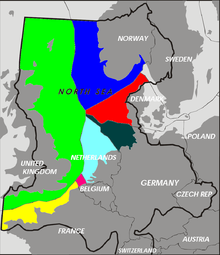
The Exclusive Economic Zones in the North Sea
Political status
Countries that border the North Sea all claim the 12 nautical miles (22 km; 14 mi) of territorial waters, within which they have exclusive fishing rights.[93] The Common Fisheries Policy of the European Union (EU) exists to coordinate fishing rights and assist with disputes between EU states and the EU border state of Norway.[94]After the discovery of mineral resources in the North Sea, the Convention on the Continental Shelf established country rights largely divided along the median line. The median line is defined as the line "every point of which is equidistant from the nearest points of the baselines from which the breadth of the territorial sea of each State is measured."[95] The ocean floor border between Germany, the Netherlands, and Denmark was only reapportioned after protracted negotiations and a judgement of the International Court of Justice.[93][96]
Oil and gas
Further information: North Sea oil and List of oil and gas fields of the North Sea
As early as 1859, oil was discovered in onshore areas around the North Sea and natural gas as early as 1910.[47]Test drilling began in 1966 and then, in 1969, Phillips Petroleum Company discovered the Ekofisk oil field[97] distinguished by valuable, low-sulphur oil.[98] Commercial exploitation began in 1971 with tankers and, after 1975, by a pipeline, first to Teesside, England and then, after 1977, also to Emden, Germany.[99]
The exploitation of the North Sea oil reserves began just before the 1973 oil crisis, and the climb of international oil prices made the large investments needed for extraction much more attractive.[100]
Although the production costs are relatively high, the quality of the oil, the political stability of the region, and the nearness of important markets in western Europe has made the North Sea an important oil producing region.[98] The largest single humanitarian catastrophe in the North Sea oil industry was the destruction of the offshore oil platform Piper Alpha in 1988 in which 167 people lost their lives.[101]
Besides the Ekofisk oil field, the Statfjord oil field is also notable as it was the cause of the first pipeline to span the Norwegian trench.[102] The largest natural gas field in the North Sea, Troll gas field, lies in the Norwegian trench dropping over 300 metres (980 ft) requiring the construction of the enormous Troll A platform to access it.
The price of Brent Crude, one of the first types of oil extracted from the North Sea, is used today as a standard price for comparison for crude oil from the rest of the world.[103] The North Sea contains western Europe's largest oil and natural gas reserves and is one of the world's key non-OPEC producing regions.[104]
Fishing

A trawler in Nordstrand, Germany
Main article: Fishing in the North Sea
The North Sea is Europe's main fishery accounting for over five percent of international commercial fish caught.[1] Fishing in the North Sea is concentrated in the southern part of the coastal waters. The main method of fishing is trawling.[105] In 1995, the total volume of fish and shellfish caught in the North Sea was approximately 3.5 million tonnes.[106] Besides fish, it is estimated that one million tonnes of unmarketable by-catch is caught and discarded each year.[107]In recent decades, overfishing has left many fisheries unproductive, disturbing marine food chain dynamics and costing jobs in the fishing industry.[108] Herring, cod and plaice fisheries may soon face the same plight as mackerel fishing, which ceased in the 1970s due to overfishing.[109] The objective of the European Union Common Fisheries Policy is to minimize the environmental impact associated with resource use by reducing fish discards, increasing productivity of fisheries, stabilising markets of fisheries and fish processing, and supplying fish at reasonable prices for the consumer.[110]
Mineral resources
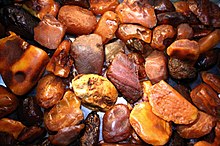
Unpolished amber stones, in varying hues
Renewable energy
Further information: Renewable energy in the European Union and List of offshore wind farms in the North Sea
Due to the strong prevailing winds, countries on the North Sea, particularly Germany and Denmark, have used the shore for wind power since the 1990s.[114] The North Sea is the home of one of the first large-scale offshore wind farms in the world, Horns Rev 1, completed in 2002. Since then many other wind farms have been commissioned in the North Sea (and elsewhere), including the two largest windfarms in the world as of September 2010; Thanet in the UK[115][116] and Horns Rev 2 in Denmark.[117]The expansion of offshore wind farms has met with some resistance. Concerns have include shipping collisions[118] and environmental effects on ocean ecology and wildlife such as fish and migratory birds,[119][120] however, these concerns were found to be negligible in a long-term study in Denmark released in 2006[121] and again in a UK government study in 2009.[122][123] There are also concerns about reliability,[124] and the rising costs of constructing and maintaining offshore wind farms.[125] Despite these, development of North Sea wind power is continuing, with plans for additional wind farms off the coasts of Germany, the Netherlands, and the UK.[126][127][128] There have also been proposals for a transnational power grid in the North Sea to connect new offshore wind farms.[129][130]
Energy production from tidal power is still in a pre-commercial stage. The European Marine Energy Centre has installed a wave testing system at Billia Croo on the Orkney mainland[131] and a tidal power testing station on the nearby island of Eday.[132] Since 2003, a prototype Wave Dragon energy converter has been in operation at Nissum Bredning fjord of northern Denmark.[133]
Tourism
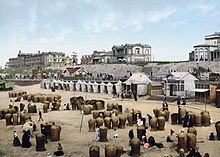
The beach in Scheveningen, Netherlands in c. 1900
The climatic conditions on the North Sea coast are often claimed to be especially healthful. As early as the 19th century, travellers used their stays on the North Sea coast as curative and restorative vacations. The sea air, temperature, wind, water, and sunshine are counted among the beneficial conditions that are said to activate the body's defences, improve circulation, strengthen the immune system, and have healing effects on the skin and the respiratory system.[139]
Marine traffic
See also: List of North Sea ports
The North Sea is important for marine transportation and its shipping lanes are among the busiest in the world.[93] Major ports are located along its coasts: Rotterdam, The busiest port in Europe and the third busiest port in the world by tonnage as of 2008, Antwerp (16th) and Hamburg (27th), Bremen/Bremerhaven and Felixstowe, both in the top 30 busiest container seaports,[140] as well as the Port of Bruges-Zeebrugge, Europe's leading RoRo port.[141]
Rotterdam, Netherlands
The North Sea coasts are home to numerous canals and canal systems to facilitate traffic between and among rivers, artificial harbours, and the sea. The Kiel Canal, connecting the North Sea with the Baltic Sea, is the most heavily used artificial seaway in the world reporting an average of 89 ships per day not including sporting boats and other small watercraft in 2009.[144] It saves an average of 250 nautical miles (460 km; 290 mi), instead of the voyage around the Jutland Peninsula.[145] The North Sea Canal connects Amsterdam with the North Sea.[146]
 Unknown
Unknown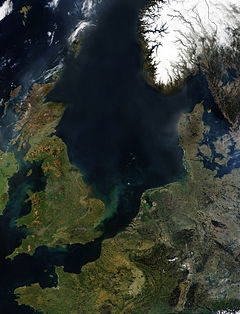

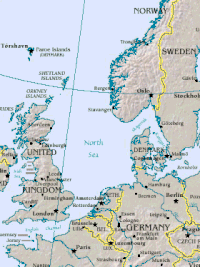





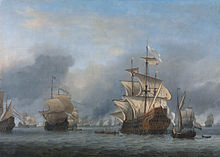

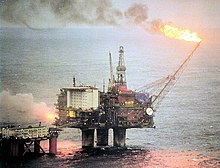









0 komentar:
Post a Comment